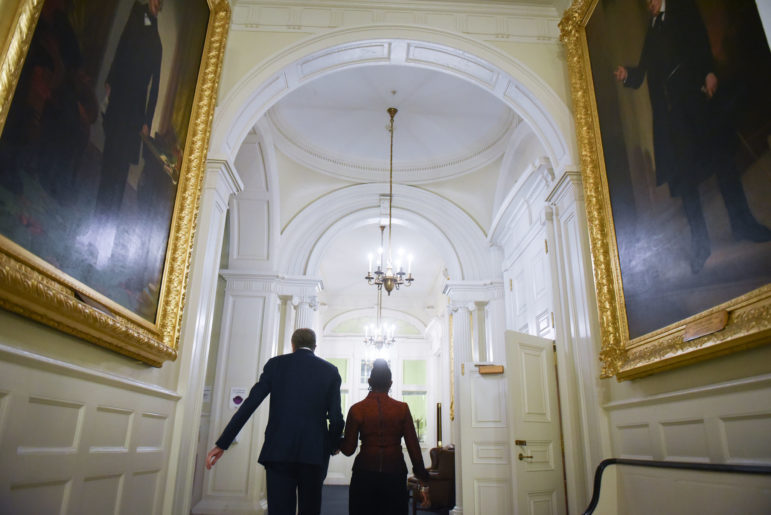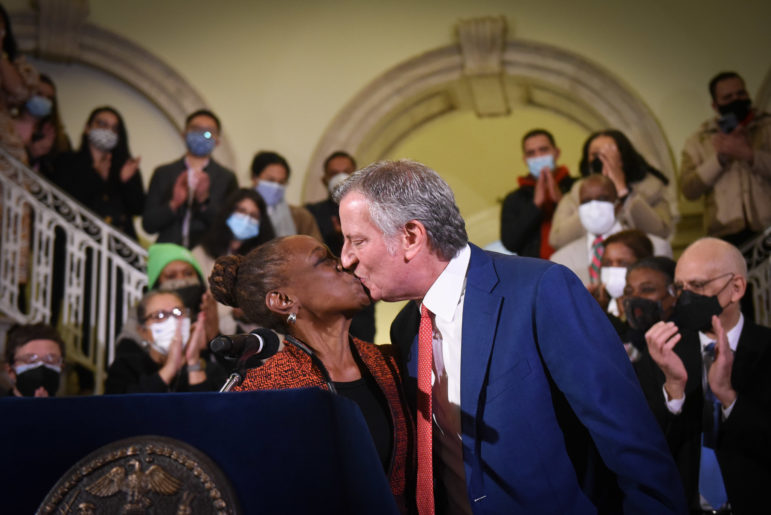“From the vantage point of future decades, his many flaws and huge mistakes—all so apparent to us who have watched his day-to-day mayoralty—are unlikely to be as visible as the major decisions he made which, in many cases, were pretty sound and made the city a better place.”

Michael Appleton/Mayoral Photography Office
Mayor Bill de Blasio and First Lady Chirlane McCray departing City Hall after the mayor’s last official press conference Thursday.In a few hours, Bill de Blasio will begin his official transition from political player to historical figure. That shift might be delayed briefly by an unsuccessful run for governor, but one way or another, the shaping of the legacy of our 109th mayor is now largely in the hands of the scholars and authors who will retell, reframe and reinterpret the story of his New York in books and documentaries of years to come.
That is likely to be good news for Bill de Blasio.
From the vantage point of future decades, his many flaws and huge mistakes—all so apparent to us who have watched his day-to-day mayoralty—are unlikely to be as visible as the major decisions he made which, in many cases, were pretty sound and made the city a better place.
Launching universal pre-Kindergarten, moving to close the jails on Rikers Island, installing a series of strong environmental programs and making his controversial but admirable push to reopen city schools after the COVID-19 shutdown are just a few of the brighter highlights. Among the others are paid sick leave, the municipal ID card and record-low changes to stabilized rents, to name a few. The fact that an activist City Council championed many of these policies first doesn’t change the fact that de Blasio eventually threw his weight behind them, which is what good mayors do when they see a good idea.
De Blasio earned his accomplishments against four considerable opponents. First, there was the city’s establishment, which resented de Blasio for beating its preferred candidate, Christine Quinn, in the 2013 Democratic primary and, in the process, exposing how out of touch it was with what was going on in its own city. Then there were the media voices that declared de Blasio’s mayoralty a managerial disaster even before he took office, linking every hint of urban dysfunction to the mayor in a manner that Mike Bloomberg and Rudy Giuliani never saw. In Albany sat a very powerful governor (now exposed as a manipulative bully) who seemed to take pleasure in thwarting the mayor. And finally, there was de Blasio himself: an arrogant micromanager with little skill for connecting with the public or his colleagues in government and a tendency to skirt ethical boundaries out of an inflated sense of his own moral purpose.
What was most frustrating about the mayor was the hit-or-miss nature of his instincts. De Blasio sensed that the national Democratic electorate was shifting to the left in 2016 (that’s one reason why he hemmed and hawed about endorsing Hillary Clinton) well before that very decisive move was visible to most observers. He warned that COVID-19 was likely to force a stay-at-home order in New York City, only to be mocked by Cuomo for suggesting such drivel, then proven right a few days later. He was right that schools could be opened safely in the fall of 2020, sparing hundreds of thousands of kids the soul-numbing sentence of months more of online learning (even if the implementation was shaky). His recent private-sector vaccine mandate was rolled out in bizarre fashion, and de Blasio caught a lot of guff for that, but Mayor-elect Adams has said he will retain it.
And yet, de Blasio thought it was a good idea to run for president. Sigh.

Michael Appleton/Mayoral Photography Office
Mayor Bill de Blasio and First Lady Chirlane McCray bidding farewell to City Hall on Thursday.De Blasio’s personal quirks and unsteady political compass were less important, however, than the mismatch that characterized his entire mayoralty: Despite his impressive height, de Blasio was never as big as the moment that elected him. His 2013 campaign tapped into a vast yearning for profound change in the city, but in his soul de Blasio was a conventional progressive incapable of delivering that kind of transformation—if anyone could. Tackling the vast social ill of income inequality was an order even taller than the mayor.
And other issues rapidly evolved to be much more challenging than de Blasio thought they’d be. His campaign pledge to sharply reduce stop-and-frisk, for example, seemed bold during his run for mayor. By the end of his first year in office, however, de Blasio was caught between an activated left that wanted sweeping changes to policing and an NYPD that literally turned its back on the mayor for his modest policies and mild criticisms. As national events like police shootings and the Trump presidency supercharged the political atmosphere, the mayor was even more at a loss. He was indeed slow to see the problems with “broken windows” policing, but soon the debate over law and order moved into an entirely different dimension: No mayor could ever have embraced the actual defunding of the police, but that is the bar against which some advocates judged him.
Nowhere was this misalignment of man and moment more clear than when it came to housing, where de Blasio proposed a series of policies that would have made the left weep with joy had they been launched 10 years earlier, before the rental market moved from crisis into failure. His plans targeted too many apartments at moderate- and middle-income levels despite the enormous unmet needs on the lower end of the income scale. Eventually, de Blasio corrected some of the mis-targeting of his housing plan, though his homelessness policies continued to founder under the weight of de Blasio’s orthodoxy.
As with policing, it is unclear that even the greatest mayor could have navigated this housing emergency unscathed: De Blasio pumped enormous resources into NYCHA, but the decades of disinvestment by Washington, Albany and previous mayors—along with his administration’s own mismanagement—meant that residents were still being failed, and de Blasio was filleted for it.
The pandemic, of course, dominated his second term. De Blasio made lots of errors responding to it, and those mistakes had real impact. Given the scale of the global disaster that is COVID-19, however, it is hard to see how the city would not have suffered a devastating blow even with flawless leadership from City Hall. That doesn’t excuse any of the mayor’s missteps; it just makes the point that any mayoralty—great, lousy or middling—is shaped by forces that the mayor has little to do with. The rosy economy that de Blasio enjoyed for the first five years of his term is another example of this.
Which brings us back to the job the scholars now have of sorting out where de Blasio deserves history’s credit and blame. He probably merits a fair share of both. The question of how to apportion them will make for interesting debates in 10 or 20 years when the books and documentaries start coming out. On topics like inequality, where de Blasio moved the needle but didn’t transform the world, he’ll have to be judged in light of his promises and the tools that were at his disposal.
For right now, the real-world value of Bill de Blasio’s scorecard is what it can teach the next generation of city leaders. Even without the benefit of much hindsight, a few lessons stand out. De Blasio’s failures and successes tell us something about the nature of leadership. Fact is, no one is big enough for the job of running New York City at a moment like this one. So leaders, please listen as much as you talk. Be as honest as you can, and a little humble. Try to inspire people to help you make real change.
And for God’s sake, don’t run for president.
Jarrett Murphy is a nursing student. A former journalist, he worked at CBS News and the Village Voice before his 2007-2021 stint at City Limits, during which he served as executive editor for 10 years and covered the de Blasio administration extensively.









3 thoughts on “Opinion: At Midnight, a New Year Begins—and History Gets its Hands on Bill de Blasio”
WONDERFULLY FULLY COMPLETE YET SUCCINT – FAIR & ERUDITE ASSESSMENT.
thank you.
Great job minimizing his pay to play corruption and how his affordable housing program was more like a luxury public housing program being that it prioritized 75-80% of the apartments for the upper class. And also how his vaccine mandate was based on extortion and cheating and it wound up resurrecting the pandemic despite his and the irresponsible health departments incessant shilling of the defective vaccines.
Good, but more data and specifics and less characterization would be better.